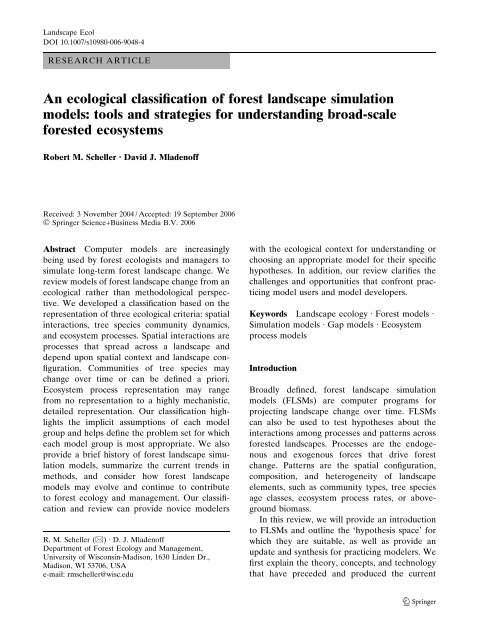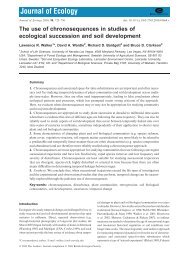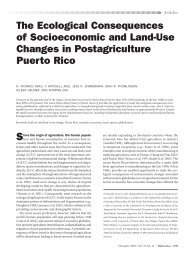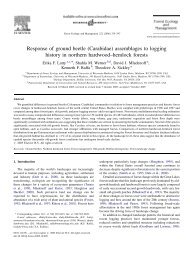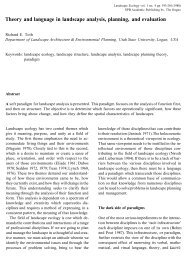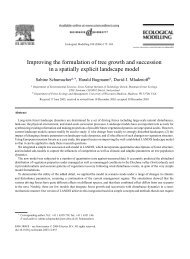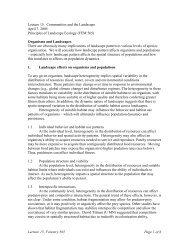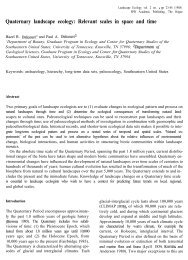Scheller and Mladenoff (PDF) - Forest Landscape Ecology Lab ...
Scheller and Mladenoff (PDF) - Forest Landscape Ecology Lab ...
Scheller and Mladenoff (PDF) - Forest Landscape Ecology Lab ...
- No tags were found...
You also want an ePaper? Increase the reach of your titles
YUMPU automatically turns print PDFs into web optimized ePapers that Google loves.
L<strong>and</strong>scape EcolDOI 10.1007/s10980-006-9048-4RESEARCH ARTICLEAn ecological classification of forest l<strong>and</strong>scape simulationmodels: tools <strong>and</strong> strategies for underst<strong>and</strong>ing broad-scaleforested ecosystemsRobert M. <strong>Scheller</strong> Æ David J. <strong>Mladenoff</strong>Received: 3 November 2004 / Accepted: 19 September 2006Ó Springer Science+Business Media B.V. 2006Abstract Computer models are increasinglybeing used by forest ecologists <strong>and</strong> managers tosimulate long-term forest l<strong>and</strong>scape change. Wereview models of forest l<strong>and</strong>scape change from anecological rather than methodological perspective.We developed a classification based on therepresentation of three ecological criteria: spatialinteractions, tree species community dynamics,<strong>and</strong> ecosystem processes. Spatial interactions areprocesses that spread across a l<strong>and</strong>scape <strong>and</strong>depend upon spatial context <strong>and</strong> l<strong>and</strong>scape configuration.Communities of tree species maychange over time or can be defined a priori.Ecosystem process representation may rangefrom no representation to a highly mechanistic,detailed representation. Our classification highlightsthe implicit assumptions of each modelgroup <strong>and</strong> helps define the problem set for whicheach model group is most appropriate. We alsoprovide a brief history of forest l<strong>and</strong>scape simulationmodels, summarize the current trends inmethods, <strong>and</strong> consider how forest l<strong>and</strong>scapemodels may evolve <strong>and</strong> continue to contributeto forest ecology <strong>and</strong> management. Our classification<strong>and</strong> review can provide novice modelersR. M. <strong>Scheller</strong> (&) Æ D. J. <strong>Mladenoff</strong>Department of <strong>Forest</strong> <strong>Ecology</strong> <strong>and</strong> Management,University of Wisconsin-Madison, 1630 Linden Dr.,Madison, WI 53706, USAe-mail: rmscheller@wisc.eduwith the ecological context for underst<strong>and</strong>ing orchoosing an appropriate model for their specifichypotheses. In addition, our review clarifies thechallenges <strong>and</strong> opportunities that confront practicingmodel users <strong>and</strong> model developers.Keywords L<strong>and</strong>scape ecology Æ <strong>Forest</strong> models ÆSimulation models Æ Gap models Æ Ecosystemprocess modelsIntroductionBroadly defined, forest l<strong>and</strong>scape simulationmodels (FLSMs) are computer programs forprojecting l<strong>and</strong>scape change over time. FLSMscan also be used to test hypotheses about theinteractions among processes <strong>and</strong> patterns acrossforested l<strong>and</strong>scapes. Processes are the endogenous<strong>and</strong> exogenous forces that drive forestchange. Patterns are the spatial configuration,composition, <strong>and</strong> heterogeneity of l<strong>and</strong>scapeelements, such as community types, tree speciesage classes, ecosystem process rates, or abovegroundbiomass.In this review, we will provide an introductionto FLSMs <strong>and</strong> outline the ‘hypothesis space’ forwhich they are suitable, as well as provide anupdate <strong>and</strong> synthesis for practicing modelers. Wefirst explain the theory, concepts, <strong>and</strong> technologythat have preceded <strong>and</strong> produced the current123
L<strong>and</strong>scape Ecol‘‘l<strong>and</strong>scape’’ of FLSMs. We place FLSMs into thebroader context of ecological modeling <strong>and</strong>examine what is unique about FLSMs. Next, wereview FLSMs using a classification that tiestogether distinct groups of FLSMs <strong>and</strong> providesan ecological perspective on l<strong>and</strong>scape models.We discuss strategies for deploying FLSMs, particularlyfor users who are not model developers.Last, we speculate about the future challenges<strong>and</strong> opportunities for FLSMs.History <strong>and</strong> development of forest modelsThe history of FLSMs mirrors the history of bothforest <strong>and</strong> l<strong>and</strong>scape ecologies. Within forestecology, there has been a long history of modeldevelopment <strong>and</strong> application, driven by managementimperatives <strong>and</strong> evolving ecological paradigms(Shugart 1998; <strong>Mladenoff</strong> <strong>and</strong> Baker1999a). <strong>Forest</strong> ecology in the United Statesinitially focused on the forest st<strong>and</strong> (typically10 3 ha) developed as forestmanagers <strong>and</strong> ecologists confronted natural disturbances(e.g., fire, hurricanes) <strong>and</strong> humaninduced stresses (e.g., l<strong>and</strong> use change, climatechange) that required the context of the largerl<strong>and</strong>scape to be sufficiently understood. Theeffects of management practices, logging in particular,also motivated the shift in perspectivetowards broader spatial <strong>and</strong> temporal scales(Franklin <strong>and</strong> Forman 1987). Over time, thisemphasis on broader scales evolved into forestecosystem management (Levin 1999), managementof disturbance regimes (Engstrom et al.1999), <strong>and</strong> forest l<strong>and</strong>scape planning (Barrett2001).In the past two decades, forest models havebenefited from ongoing improvements in technology<strong>and</strong> data availability (<strong>Mladenoff</strong> 2004).Computer speed <strong>and</strong> memory have increaseddramatically, following Moore’s prediction of adoubling of transistors per integrated circuit every18 months (Moore 1965). Simultaneously, softwarehas eased model development <strong>and</strong> themanipulation of input <strong>and</strong> output data. Hardware<strong>and</strong> software improvements have increased ourability to simulate many processes at multiplescales. The availability of data to parameterize,initialize, <strong>and</strong> validate forest models has alsoincreased significantly. Spatially extensive dataare now readily available from either satelliteclassifications (Wolter et al. 1995; Defries et al.2000), national surveys (Hansen et al. 1992;STATSGO 1994), <strong>and</strong> historical data sources(Schulte et al. 2002).<strong>Forest</strong> l<strong>and</strong>scape simulation modelsWithin this broader context, FLSMs were designedspecifically to address management orresearch questions about spatially extensive l<strong>and</strong>scapes.All FLSMs are spatially explicit: l<strong>and</strong>scapeelements have map coordinates <strong>and</strong> areplaced within their geographic context. L<strong>and</strong>scapeelements must be assigned values beforesimulating a l<strong>and</strong>scape, i.e., the l<strong>and</strong>scape musthave an initial configuration. A geographic informationsystem (GIS) is typically used to input,store, <strong>and</strong> display data. FLSMs may also bespatially interactive, i.e., simulate lateral (horizontal)fluxes or processes that spread across thel<strong>and</strong>scape (Reiners <strong>and</strong> Driese 2001; <strong>Mladenoff</strong>2004; Peters et al. 2004).Another distinctive feature of FLSMs is theiremphasis on large-scale forcing, including disturbance(Baker 1989; <strong>Mladenoff</strong> <strong>and</strong> Baker 1999b).The types of disturbances that have been modeledare extensive, although wild fire has been thelargest focus of previous modeling (Keane <strong>and</strong>Long 1998; Keane et al. 2004). Human effects onl<strong>and</strong>scape change have also become a significantfocus, including harvesting (Wallin et al. 1994;Gustafson <strong>and</strong> Crow 1998; Gustafson et al. 2000),123
L<strong>and</strong>scape Ecol<strong>Forest</strong> L<strong>and</strong>scape Simulation Modelsexcluding spatialinteractionsincluding spatialinteractionsstaticcommunitiesdynamiccommunitiesstaticcommunitiesdynamiccommunitiesexcludingecosystemprocessesincludingecosystemprocessesexcludingecosystemprocessesGroup 1 Group 2 Group 3DOLY 2 TEM-LPJ 5MAPSS 1,2 IBIS 3 NoneBIOME2 2 MC1 4includingecosystemprocessesexcludingecosystemprocessesincludingecosystemprocessesexcludingecosystemprocessesincludingecosystemprocessesGroup 4 Group 5 Group 6 Group 7 Group 8ForClim 7 TELSA 8 MC1 4 LANDIS 13 FIRE-BGC 16EMBYR 10HARVEST 9MetaFor 14 LANDIS-II 17LINKAGES 6 VDDT/ SEM-LAND 11 LANDSIM 12 FACET 15Fig. 1 An example decision tree based on three ecologicalcriteria: inclusion of spatial interactions, static or dynamiccommunities, <strong>and</strong> inclusion of ecosystem processes. Theorder of the decision tree can be reconfigured, dependentupon the individual’s ranking of the three criteria. Groupnumbers correspond to the group labels in the text. Two orthree exemplar models are provided for each group.Subscripts.1 Neilson (1995);2 VEMAP Members (1995);3 Foley et al. (1996); 4 Bachelet et al. (2001a, b); 5 Pan et al.(2002);6 Pastor <strong>and</strong> Post (1986a);7 Bugmann (1996);8 Klenner et al. (2000);9 Gustafson <strong>and</strong> Crow (1998);10 Hargrove et al. (2000); 11 Li (2000); 12 Roberts (1996b);13 <strong>Mladenoff</strong> et al. (1996); 14 Urban et al. (1999); 15 Urban<strong>and</strong> Shugart (1992); 16 Keane et al. (1996); 17 <strong>Scheller</strong> et al.(in review)patterning at multiple scales <strong>and</strong> thereforecontribute to the evolution of l<strong>and</strong>scape pattern<strong>and</strong> changes in spatial heterogeneity. Examplesof spatial interactions include the dispersalof seeds, a fire spreading, the movement ofherbivores, <strong>and</strong> neighboring trees competing forlight.Essential to the simulation of spatial interactionsis the representation of spatial information<strong>and</strong> the neighborhood structure. Vector polygonsare contiguous areas that can have any size orshape within the maximum extent of the l<strong>and</strong>scape(Fig. 2A). Vector polygons assume withinpolygonhomogeneity. Spatial interactions amongvector polygons are often limited to first-orderneighbors, defined by a shared edge betweenpolygons (Fig. 2A). A l<strong>and</strong>scape can also bebroken into a grid of equal sized, typically squareor hexagonal, cells. Spatial interactions amongcells can be defined by either neighborhoods (e.g.,the 4, 8, or 12 nearest neighbors; Fig. 2B) <strong>and</strong>/orcan be a function of the distance between cellcenter points (Fig. 2C), thereby allowing moreflexibility in spatial interactions than vector polygons(<strong>Mladenoff</strong> <strong>and</strong> He 1999; <strong>Mladenoff</strong> <strong>and</strong>Baker 1999b).Every representation of spatial interactionsincurs a computational penalty. Finer resolutionspatial interactions (e.g., neighborhood shading)will incur a larger computational penalty thancoarse-scale interactions (e.g., the dispersion oflarge clear-cut patches). The computational costof a spatial interaction is sensitive to l<strong>and</strong>scaperesolution <strong>and</strong> increases non-linearly withdecreasing cell size.Finally, the simulation of a particular spatialinteraction may not be appropriate for a givenhypothesis or scale (Peters et al. 2004). Forexample, at continental scales, most l<strong>and</strong>scapevariation will be explained by patterns of temperature<strong>and</strong> precipitation. Conversely, shorttermprojections may not require estimates ofcontinental tree species migrations. If spatialinteractions provide only a marginal increase inpredictive power, the additional complexity,computational overhead, <strong>and</strong> parameterizationrequired may not warrant their inclusion (Peterset al. 2004).123
L<strong>and</strong>scape EcolFig. 2 Sampleneighborhood structures:(A) polygons with first<strong>and</strong> second orderneighborhoods; (B) a gridwith 4, 8, <strong>and</strong> 12 cellneighborhoods. Largerneighborhoods include allcells from smallerneighborhoods; (C) anunstructuredneighborhood wherespatial interaction is afunction of distance fromthe focal cell. Resolution<strong>and</strong> extent are arbitrary<strong>and</strong> are not indicative ofneighborhood structure orinteractionsAFfocal polygon (F)1 st order neighbor2 nd order neighborBFfocal cell (F)4 nearest neighbors8 nearest neighbors12 nearest neighborsCFStatic or dynamic communitiesAll FLSMs include spatial <strong>and</strong> temporal changeof tree species composition—forests change overtime. How a community of tree species is representedvaries widely <strong>and</strong> will be explored below.The principle difference among FLSMs iswhether the community itself is static or dynamic.For a static community, tree species composition<strong>and</strong> associated characters are defined a priori <strong>and</strong>do not evolve during a simulation, although thespatial distribution of the community will changeover time. This property has been termed the‘invariance hypothesis’ (Logofet <strong>and</strong> Lesnaya2000). A dynamic community is not fixed <strong>and</strong>the composition <strong>and</strong> character of simulated communitieswill evolve over time.<strong>Forest</strong> communities can be represented assuccessional stages or ‘seral community types’(Cattelino et al. 1979; Keane <strong>and</strong> Long 1998). Theterms ‘community state’, ‘vegetation classification’,<strong>and</strong> ‘l<strong>and</strong> cover type’ also apply (Yemshanov<strong>and</strong> Perera 2002). A successional stage isassociated with species, age, <strong>and</strong>/or biogeochemicalinformation. Successional pathways are typical,likely, or potential transitions amongsuccessional stages. Without disturbance, thesepathways will converge on a single ‘‘climax’’community or potential vegetation type (Keane<strong>and</strong> Long 1998; Logofet <strong>and</strong> Lesnaya 2000).Transitions occur after a certain time passes ordisturbance occurs (Klenner et al. 2000; Keaneet al. 2002). Alternatively, time dependent transitionsprobabilities (Markov chain) can be used(Balzter et al. 1998; Logofet <strong>and</strong> Lesnaya 2000;Yemshanov <strong>and</strong> Perera 2002). Successionalstages, pathways, <strong>and</strong> transition probabilitiesare often estimated from st<strong>and</strong>-scale models123
L<strong>and</strong>scape Ecol(Acevedo et al. 2001), multi-temporal data (Turneret al. 1996), field measurements (Logofet <strong>and</strong>Lesnaya 2000; Yemshanov <strong>and</strong> Perera 2002), orsubjectively defined by managers <strong>and</strong> forestecologists.Since successional stage models have staticcommunities, their application is limited to stableecosystems or short time horizons. For example,climate change or species invasion will likely altersuccessional processes <strong>and</strong> cannot be modeledwith static communities. Another critical assumptionis that all successional pathways are known<strong>and</strong> that novel combinations of species will notoccur. Finally, the use of static communitiestypically assumes that all species propagules areuniversally available.Alternatively, other FLSMs explicitly includediscrete tree species <strong>and</strong> their life history traits(<strong>Mladenoff</strong> et al. 1996; Roberts 1996a). Speciescan be recorded as present or absent, stratifiedinto classes (diameter <strong>and</strong> age classes being themost common), or recorded as individual trees.The inclusion of discrete species implicitlyassumes that forest change can only be adequatelypredicted by considering individual specieslife history attributes, physiology, behavior,<strong>and</strong>/or biochemistry. Communities representedby multiple species, each individually respondingto changing environmental drivers, are dynamic<strong>and</strong> will evolve over time. Although apparentlymore flexible, dynamic communities require thata greater number of demographic processes beparameterized <strong>and</strong> simulated, including at leastbirth, ageing, <strong>and</strong> death. The duration of themodel simulation <strong>and</strong> the estimated stability ofcommunity types will determine whether simulatinga dynamic community is justified, given theadditional parameterization required.Ecosystem processesEcosystem processes encompass a broad range ofbiophysical <strong>and</strong> biological processes that mediatethe exchange of energy <strong>and</strong> matter between bioticpools <strong>and</strong> the abiotic environment. Within forests,ecosystem ecology has traditionally focused onnutrient cycling, productivity, <strong>and</strong> decomposition(Whittaker et al. 1974; Pastor <strong>and</strong> Post 1986b;Rastetter et al. 1991; Saxe et al. 2001). FLSMsthat explicitly include ecosystem processes typicallysimulate the net growth of trees (photosyntheticcarbon fixation minus autotrophicrespiration) at a minimum. Complexity <strong>and</strong> detailincrease as biotic pools are added or furtherdivided, more processes are included (e.g., heterotrophicrespiration), <strong>and</strong> time scales are shortened.Inclusion of ecosystem processes may be particularlyrelevant when abiotic constraints are notexpected to remain constant, as may be the casewith climate change, changes in atmosphericchemistry, or nutrient deposition (Pitelka et al.2001; Saxe et al. 2001). Ecosystem processes arealso important when there are feedbacks betweenbiological processes (e.g., succession) <strong>and</strong> ecosystemfunction (e.g., water retention, nitrogencycling) (Pastor <strong>and</strong> Post 1986b; Hooper <strong>and</strong>Vitousek 1997).Functional classification of forest l<strong>and</strong>scapesimulation modelsFor each of the three ecological criteria, weclassified FLSMs on the basis of the inclusion orexclusion of these processes (spatial interactionsexcluded or included; static or dynamic communities;ecosystem processes excluded or included),providing a total of eight model groups. Thesethree ecological criteria were used to form abinary decision tree (Fig. 1). Since our classificationwas intended to highlight assumptions <strong>and</strong>perspectives, we provide only examples <strong>and</strong> manyexcellent models have not been listed here. Thereare many other reviews that together can providea more comprehensive list of available models(Baker 1989; <strong>Mladenoff</strong> <strong>and</strong> Baker 1999a; Gratzeret al. 2004; Keane et al. 2004; Perry <strong>and</strong>Enright 2006).Group 1. Excluding spatial interactions; staticcommunities; excluding ecosystem processesMany of the models in this group <strong>and</strong> the nextwere designed to project broad-scale (continentalto global) change. Species are amalgamatedinto plant functional types (PFTs, e.g., ‘temperateconifer’) with homogeneous physiological attributes(growth rates, structure, disturbance123
L<strong>and</strong>scape Ecoltolerance, etc.). PFTs are not limited to foresttypes but also include tundra, grassl<strong>and</strong>s, savannas,shrub l<strong>and</strong>s, <strong>and</strong> arid l<strong>and</strong>s (Neilson 1995;Neilson <strong>and</strong> Drapek 1998; Bachelet et al. 2001a,b, 2003). Transitions between PFTs are dependentupon climate change, soils, disturbance, <strong>and</strong>the physiological constraints for each PFT.Specific to Group 1 are Dynamic GlobalVegetation Models (DGVMs). DGVMs projectshifts in the location of vegetation types as afunction of climate. Disturbances are generallynot simulated. For example, the Mapped Atmosphere-Plant-SoilSystem (MAPSS) projectswhere different forest types are likely to persistusing current or projected climate <strong>and</strong> broadestimates of fundamental niches (VEMAP Members1995; Neilson 1995; Neilson <strong>and</strong> Drapek1998).DGVMs have been criticized because of theirassumption that PFTs can migrate rapidly <strong>and</strong>remain in equilibrium with climate (Pearson <strong>and</strong>Dawson 2003). The validity of this assumptionwill depend on the functional diversity of thePFTs. Since these <strong>and</strong> similar models do notincorporate dispersal, disturbance, or humanfragmentation of the l<strong>and</strong>scape, the results shouldnot be regarded as either predictions or projections.Instead, the results define a baseline estimateof where various forests types could exist,given the projected climate change. These modelsprovide valuable broad scale data <strong>and</strong> serve as animportant contrast to more regional, strictlyforest models.Group 2. Excluding spatial interactions; staticcommunities; including ecosystem processesThis group of models simulate changes in vegetation<strong>and</strong> various carbon pools at continental toglobal scales (Foley et al. 1996; Lenihan et al.1998; Mcguire et al. 2001; Cramer et al. 2001;Aber et al. 2001; Bachelet et al. 2003). Similar tothe first group, communities are not limited toforest tree species <strong>and</strong> seed dispersal is notlimiting. Disturbances are simulated to occur ator below the resolution of the grid cell (Thonickeet al. 2001) <strong>and</strong> therefore there are no explicitspatial interactions. Within a PFT, there is novariation in disturbance effects. For example, allspecies within the conifer plant functional type(Bachelet et al. 2001a, b) will react identically,with no variation due to serotiny, bark thickness,epicormic branching, etc. Finally, these models donot yet incorporate human influences, particularlylogging or fragmentation.Nevertheless, because of the very large spatialextents that can be simulated, such models arevaluable for evaluating broad-scale changes incarbon stocks or nutrient cycling due to interactionsbetween the terrestrial biome <strong>and</strong> theatmosphere. Similar to the first group, thesemodels can also define potential vegetation atbroad (continental) scales.Group 3. Excluding spatial interactions; dynamiccommunities; excluding ecosystem processesWhen simulating dynamic communities, modeldevelopers have usually made an implicit choicebetween including ecosystem processes or includingspatial interactions, both of which are computationallyexpensive. Consequently, currentlythere are no FLSMs with dynamic communities<strong>and</strong> neither spatial interactions nor ecosystemprocesses.Group 4. Excluding spatial interactions; dynamiccommunities; including ecosystem processesMany of the first models that included dynamicspecies composition <strong>and</strong> ecosystem processeswere gap models (Urban <strong>and</strong> Shugart 1992).Gap models operate at the scale of individualtrees or small forest gaps, typically an area lessthan 0.1 ha (Urban <strong>and</strong> Shugart 1992; Shugart1998). Gap models simulate individual treegrowth <strong>and</strong> mortality <strong>and</strong> may include decomposition.Therefore gap models represent at leastone ecosystem process <strong>and</strong> simulate dynamicspecies composition. Although individual treesare modeled, they are not given explicit spatialcoordinates. Nor is the larger l<strong>and</strong>scape contextrepresented. Seeds are assumed to be universallydistributed <strong>and</strong> disturbances are not modeled asspatially dynamic processes.Although gap models have been linkedtogether to model larger l<strong>and</strong>scapes (Urban et al.1991; Busing 1991; Easterling et al. 2001), the123
L<strong>and</strong>scape Ecolapplication of linked gap models at scales >10 2 hahas been limited due to high computationaldem<strong>and</strong>s <strong>and</strong> the intensive input data required(<strong>Mladenoff</strong> 2004). The calculation of disturbanceeffects on individual trees is inherently complex(Hely et al. 2003) <strong>and</strong> spatial interactions withinlinked-gap models are typically limited to finescaleprocesses, including fire, seed dispersal, <strong>and</strong>competition (Miller <strong>and</strong> Urban 1999; Easterlinget al. 2001).Nevertheless, gap models have played a criticalrole forming the links between ecosystem processrates <strong>and</strong> dynamic communities. In addition, gapmodels have become an important source of inputdata for broader-scale FLSMs (He et al. 1998;Urban et al. 1999; Acevedo et al. 2001; <strong>Scheller</strong>et al. 2005).Group 5. Including spatial interactions; staticcommunities; excluding ecosystem processesWithin this model group, community types aresometimes extraordinarily broad with the l<strong>and</strong>scapedivided only into forested (with forest age)<strong>and</strong> non-forested types. Such models commonlyserve as ‘null’ models for exploring interactionsamong l<strong>and</strong>scape processes <strong>and</strong> a small number ofstate variables. Such null models have been usedextensively to simulate fires, including the effectsof l<strong>and</strong>scape connectivity on fire spread (Turneret al. 1989), fires <strong>and</strong> fuel moisture (Turner et al.1995; Finney 1998), or time since last fire (Bakeret al. 1991; Baker 1992, 1993; Peterson 2002).Null models have also been used to simulatespecies dispersal <strong>and</strong> rate of spread (Hart <strong>and</strong>Gardner 1997) <strong>and</strong> the effects of harvesting onl<strong>and</strong>scape pattern (Wallin et al. 1994; Gustafson<strong>and</strong> Crow 1998).Other models within this group focus on thetransitions between community types due todisturbances (generally fire <strong>and</strong> logging) (Klenneret al. 2000). Successional stages (<strong>and</strong> any associatedecosystem properties) <strong>and</strong> transition probabilitiesamong stages are calculated a priori.Using relatively simple community types <strong>and</strong>likely transitions has enabled rapid model deploymentbased on surveys of expert knowledge(Klenner et al. 2000).Models in Group 5 benefit from the emphasison spatial interactions. Limiting the array ofpossible interactions (with species, with ecosystemprocesses) has yielded important insights onthe interactions between disturbances <strong>and</strong> l<strong>and</strong>scapepattern or between disturbances <strong>and</strong> thedistribution of different community types.Group 6. Including spatial interactions; staticcommunities; including ecosystem processesSeveral spatially interactive models simulate ecosystemprocesses <strong>and</strong> have static communities.Again, static communities dictate certain assumptions.For example, MC1, which operates withoutspatial interactions at continental scales, has beenapplied to a smaller l<strong>and</strong>scape (1250 ha) throughthe inclusion of a fire spread module (Bacheletet al. 2000). The application of MC1 to a grassl<strong>and</strong>-forestecotone assumed that all propaguleswere available throughout the l<strong>and</strong>scape (Bacheletet al. 2000). Similarly, SEM-LAND simulatesforest growth <strong>and</strong> fire spread (Li 2000). Notably,SEM-LAND assumes that the climate is stable<strong>and</strong> forest type never changes, although age <strong>and</strong>biomass accumulation are dynamic (Li 2000).These models can address local or regionalscale questions (
L<strong>and</strong>scape Ecoldisturbance, <strong>and</strong> l<strong>and</strong>scape patterns (Roberts1996a). Later models extended species age categoriesto grids that allowed spatial interactionsbeyond the first-order neighborhood (<strong>Mladenoff</strong>et al. 1996; Urban et al. 1999). For example,LANDIS includes many types of spatially interactiveprocesses, each with its own neighborhoodstructure (He <strong>and</strong> <strong>Mladenoff</strong> 1999; Gustafsonet al. 2000; Sturtevant et al. 2004).However, the emphasis on individual speciesbehavior can introduce significant uncertainty.For example, mean <strong>and</strong> maximum seed dispersaldistances for many tree species remains unresolved(Clark 1998; Higgins et al. 2003). Assemblingthe necessary species data can be timeconsuming <strong>and</strong> may require significant estimation.All of these models generate estimates ofspecies age distributions across a forested l<strong>and</strong>scape.Species age distribution data provide anopportunity to link to many other processescorrelated with age, including reproduction <strong>and</strong>mortality, harvesting, <strong>and</strong> the development ofuneven-aged st<strong>and</strong> characteristics (<strong>Scheller</strong> et al.2005). Significantly, they provide estimates ofl<strong>and</strong>scape-scale demographics that are necessaryfor identifying local extinction risk (Syphard et al.2006; <strong>Scheller</strong> et al. 2005).Group 8. Including spatial interactions; dynamiccommunities; including ecosystem processesFLSMs that include spatial interactions, dynamiccommunities, <strong>and</strong> ecosystem processes are amore recent development. At a relatively smallextent (typically 10 4 ha) often represent ecosystem processesusing relatively simple growth, mortality, <strong>and</strong>decay functions (Keane et al. 1996; <strong>Scheller</strong> <strong>and</strong><strong>Mladenoff</strong> 2004). By necessity, such modelsexclude many finer-scale interactions, such asshading caused by neighboring cells. These modelsbenefit from direct <strong>and</strong> indirect links torelatively simple ecosystem process models, suchas PnET-II (Aber <strong>and</strong> Federer 1992; <strong>Scheller</strong> <strong>and</strong><strong>Mladenoff</strong> 2004) or FOREST-BGC (Running <strong>and</strong>Gower 1991; Keane et al. 1996) <strong>and</strong> simultaneouslyinclude broad-scale spatial interactions<strong>and</strong> dynamic communities.DiscussionStrategies for deploying FLSMsIncreases in model availability <strong>and</strong> usabilityprovide an opportunity to open up the modelingprocess to more forest ecologists <strong>and</strong> managers.However, a friendly interface cannot overcomethe inherent limitations found in every model.Modeling requires many choices between extent<strong>and</strong> resolution, precision <strong>and</strong> generality, accuracy<strong>and</strong> meaningful prediction, parameterization <strong>and</strong>validation (Levins 1966; Baker <strong>and</strong> <strong>Mladenoff</strong>1999; <strong>Mladenoff</strong> 2004).Our classification can serve as a guide insofaras it can help elucidate what kind of model will beappropriate for a researcher or manager. Eachresearch question will require that differentweights be applied to our three criteria <strong>and</strong> theclassification system can be customized into aunique decision tree based on an individualranking of the three criteria. Although eachmodel group is diverse, there are commonassumptions within each group that will limithypothesis testing or the scope of the projections123
L<strong>and</strong>scape Ecolgenerated. Often, the scale or resolution ofpotential hypotheses is implicitly limited withina group. Whether a particular FLSM will beappropriate is dependent upon the model’s generality,availability, <strong>and</strong> the quality of documentation.If the creation of a new FLSM is required,our classification can serve as a guide to makingassumptions <strong>and</strong> balancing comprehensiveness<strong>and</strong> tractability.An equally important decision is the choice ofscenarios. Scenarios can produce projections ofl<strong>and</strong>scape change or can be used to test hypotheses(Aber 1998; Dale <strong>and</strong> Winkle 1998). Dependentupon the confidence in the simulated processformulation, one approach or the other may beappropriate, but rarely both. Comparisons amongscenarios can provide meaningful indicators oftrends <strong>and</strong> likely changes in system behavior.Management decisions can immediately benefitfrom these general indicators of the consequencesof management choices (Carpenter 2000; Clarket al. 2001). Alternatively, scenarios can be usedto test hypotheses at temporal <strong>and</strong> spatial extentsfor which no other route to hypothesis testingexists (Pielke 2003). In this sense, FLSMs aresimilar to any tool in that deciding how to use thetool is as important as choosing the proper tool.Although the scope <strong>and</strong> application of FLSMscontinues to exp<strong>and</strong>, FLSMs are never appropriatefor making predictions about the timing <strong>and</strong>location of events. The causes that precipitatesudden l<strong>and</strong>scape change (including disturbance<strong>and</strong> l<strong>and</strong> use change) are driven by stochastic oridiosyncratic events that prevent site <strong>and</strong> timespecific prediction. Furthermore, the inherentcomplexity of FLSMs limits their predictivepower (Oreskes 2003) <strong>and</strong> no FLSM can representall relevant processes. Model results shouldtherefore always be presented as qualified ‘projections’(Dale <strong>and</strong> Winkle 1998). These projectionsare limited by our ability to formulatemeaningful questions <strong>and</strong> describe plausiblefutures through scenarios.Remaining challengesValidation remains a challenge at broad spatial<strong>and</strong> temporal scales (Rastetter 1996), particularlyunder unexpected environmental conditions, asmay be produced by climate change or speciesinvasions (Rykiel 1996; Rastetter 1996). Wedefine validation as the ‘quantitative comparisonof model results against observations’ (Prisley <strong>and</strong>Mortimer 2004). Although tools for validatingknown l<strong>and</strong>scape patterns exist (Gardner <strong>and</strong>Urban 2003), validation of many l<strong>and</strong>scape-scalephenomena remains difficult. For example, U.S.<strong>Forest</strong> Inventory <strong>and</strong> Analysis (FIA) data arespatially extensive but the resolution of the data isrelatively coarse (Hansen et al. 1992). At best,FIA data can only provide bounds for modeloutput. Similarly, analyses of existing empiricaldata for corroboration can suffer from unevenspatial <strong>and</strong> temporal resolution, differing units,<strong>and</strong> varying motivations for data collection. Nevertheless,validation is not insurmountable. Asmore FLSMs generate increasingly quantitativeprojections <strong>and</strong> more empirical data becomeavailable, greater validation of individual ecologicalprocesses (represented as model components)is possible. After achieving such reductionistvalidation, the validation of the interactionsbetween processes will be the next significantchallenge.Another large contribution of FLSMs can be toour underst<strong>and</strong>ing of uncertainty. Uncertaintycan be divided into three components: modeluncertainty (internal representation of an ecologicalprocess), inherent uncertainty (stochasticvariation), <strong>and</strong> parameter uncertainty (the measured<strong>and</strong> natural variation of model inputs)(Higgins et al. 2003; Peters et al. 2004). FLSMswith a flexible architecture can help quantifymodel uncertainty by allowing different algorithmsto be tested within the same modelingframework, thereby isolating the effects of processrepresentation. Model uncertainty can alsobe assessed through cross-model comparisons(e.g., VEMAP Members 1995; Badeck et al.2001; Burke et al. 2003). Inherent uncertaintycan be assessed within FLSMs by incorporatingstochastic variation when simulating many processes.Scenarios can address parameter uncertaintyby encompassing significant sources ofuncertainty. For example, if future disturbancerates are highly uncertain, scenarios could bedesigned to represent the highest <strong>and</strong> lowestexpected disturbance rates. New computational123
L<strong>and</strong>scape Ecolmethods have also been developed to separatethe relative contribution of sources of uncertainty<strong>and</strong> increase inferential <strong>and</strong> predictive power(Clark 2005).Finally, many existing models risk becoming‘black boxes’ to model users <strong>and</strong> many implicitassumptions are often overlooked. Consequently,the risk of mis-application <strong>and</strong> misunderst<strong>and</strong>ingof model results will increase. Therefore greatertransparency in model intentions, assumptions,<strong>and</strong> limitations will be required for furtheracceptance by managers <strong>and</strong> policy makers (Aberet al. 2003). In this regard, advances in modelarchitecture (<strong>Scheller</strong> et al. in press) <strong>and</strong> implementationof the emerging open-source paradigmcan increase model rigor while simultaneouslyenhancing comprehension.ConclusionsFLSMs reflect the changing focus of ecology <strong>and</strong>society (<strong>Mladenoff</strong> 2004). Placing FLSMs intothis broader context highlights the implicit <strong>and</strong>explicit assumptions <strong>and</strong> the ecological choicesthat ultimately dictated their design <strong>and</strong> behavior.Model designers <strong>and</strong> users must acknowledgethese compromises, assumptions, <strong>and</strong> weaknessesif their results are to be used by policy or decisionmakers.FLSMs have made tremendous contributions tounderst<strong>and</strong>ing forest l<strong>and</strong>scape change <strong>and</strong> havebeen particularly valuable to forest management.Nevertheless, many management challenges remainto be substantially addressed at broad scales.Examples include the effects of nutrient deposition,changes in atmospheric chemistry, exotic orinvasive species, <strong>and</strong> l<strong>and</strong>scape change caused byrural development <strong>and</strong> fragmentation. These <strong>and</strong>other issues confronting managers <strong>and</strong> policymakers can be expected to increase the need forFLSMs <strong>and</strong> will likely determine the future scope<strong>and</strong> application of FLSMs.Acknowledgements Dean Urban <strong>and</strong> two anonymousreviewers provided an excellent review <strong>and</strong> contributedsignificantly to the final product. Numerous other peoplehave provided critical review, including Monica Turner,Stephen Carpenter, <strong>and</strong> Volker Radeloff.ReferencesAber JD (1998) Mostly a misunderst<strong>and</strong>ing, I believe. BullEcol Soc Am 79:256–259Aber JD, Federer CA (1992) A generalized, lumpedparametermodel of photosynthesis, evapotranspiration<strong>and</strong> net primary production in temperate <strong>and</strong>boreal forest ecosystems. Oecologia 92:463–474Aber JD, Neilson RP, McNulty S, Lenihan JM, BacheletD, Drapek RJ (2001) <strong>Forest</strong> processes <strong>and</strong> globalenvironmental change: predicting the effects of individual<strong>and</strong> multiple stressors. Bioscience 51:735–751Aber JD, Bernhardt ES, Dijkstra FA, Gardner RH,Macneale KH, Parton WJ, Pickett STA, Urban DL,Weathers KC (2003) St<strong>and</strong>ards of practice for review<strong>and</strong> publication of models: summary of discussion. In:Canham CD, Cole JJ, Lauenroth WK (eds) Models inecosystem science. Princeton University Press, Princeton,New Jersey, USA, pp 204–210Acevedo MF, Ablan M, Urban DL, Pamarti S (2001)Estimating parameters of forest patch transitionmodels from gap models. Environ Model Softw16:649–658Bachelet D, Lenihan JM, Daly C, Neilson RP (2000)Interactions between fire, grazing <strong>and</strong> climate changeat Wind Cave National Park, SD. Ecol Model134:229–244Bachelet D, Lenihan JM, Daly C, Neilson RP, Ojima DS,Parton WJ (2001a) MC1: a dynamic vegetationmodel for estimating the distribution of vegetation<strong>and</strong> associated ecosystem fluxes of carbon, nutrients,<strong>and</strong> water. PNW-GTR-508. USDA <strong>Forest</strong> ServicePacific Northwest Research Station, Portl<strong>and</strong>, OR,USABachelet D, Neilson RP, Lenihan JM, Drapek RJ (2001b)Climate change effects on vegetation distribution <strong>and</strong>carbon budget in the United States. Ecosystems4:164–185Bachelet D, Neilson RP, Hickler T, Drapek RJ, LenihanJM, Sykes MT, Smith B, Sitch S, Thonicke K (2003)Simulating past <strong>and</strong> future dynamics of naturalecosystems in the United States. Global BiogeochemCycles 17:1–21Badeck F, Lischke H, Bugmann H, Hickler T, HonningerK, Lasch P, Lexer MJ, Mouillot F, Schaber J, Smith B(2001) Tree species composition in European pristineforests: comparison of st<strong>and</strong> data to model predictions.Clim Change 51:307–347Baker WL (1989) A review of models of l<strong>and</strong>scape change.L<strong>and</strong>sc Ecol 2:111–333Baker WL (1992) Effects of settlement <strong>and</strong> fire suppressionon l<strong>and</strong>scape structure. <strong>Ecology</strong> 73:1879–1887Baker WL (1993) Spatially heterogeneous multi-scaleresponse of l<strong>and</strong>scapes to fire suppression. Oikos66:66–71Baker WL, <strong>Mladenoff</strong> DJ (1999) Progress <strong>and</strong> futuredirections in spatial modeling of forest l<strong>and</strong>scapes. In:<strong>Mladenoff</strong> DJ, Baker WL (eds) Spatial modeling offorest l<strong>and</strong>scape change. Cambridge University Press,Cambridge, UK, pp 333–349123
L<strong>and</strong>scape EcolBaker WL, Egbert SL, Frazier GF (1991) A spatial modelfor studying the effects of climatic change on thestructure of l<strong>and</strong>scapes subject to large disturbances.Ecol Model 56:109–125Balzter H, Braun PW, Kohler W (1998) Cellular automatamodels for vegetation dynamics. Ecol Model 107:113–125Barrett TM (2001) Models of vegetative change forl<strong>and</strong>scape planning: a comparison of FETM, LAND-SUM, SIMPPLLE, <strong>and</strong> VDDT. RMRS-GTR-76-WWW. USDA <strong>Forest</strong> Service Rocky MountainResearch Station, Ogden, UT, USABotkin DB, Janak JF, Wallis JR (1973) Some ecologicalconsequences of a computer model of forest growth. JEcol 60:849–872Bugmann HKM (1996) A simplified forest model to studyspecies composition along climate gradients. <strong>Ecology</strong>77:2055–2074Burke IC, Kaye JP, Bird SP, Hall SA, McCulley RL,Sommerville GL (2003) Evaluating <strong>and</strong> testing modelsof terrestrial biogeochemistry: the role of temperaturein controlling decomposition. In: Canham CD,Cole JJ, Lauenroth WK (eds) The role of models inecosystem science. Princeton University Press, Princeton,NJ, USA, pp 225–253Busing RT (1991) A spatial model of forest dynamics.Vegetatio 92:167–179Carpenter SR (2000) Ecological futures: building anecology of the long now. <strong>Ecology</strong> 83:2069–2083Cattelino PJ, Noble IR, Slatyer RO, Kessell SR (1979)Predicting the multiple pathways of plant succession.Environ Manage 3:41–50Clark JS (1998) Why trees migrate so fast: confrontingtheory with dispersal biology <strong>and</strong> the paleorecord.Am Nat 152:204–224Clark JS (2005) Why environmental scientists are becomingBayesians. Ecol Lett 8:2–14Clark JS, Carpenter SR, Barber M, Collins S, Dobson A,Foley JA, Lodge DM, Pascual M, Pielke R Jr, Pizer W,Pringle C, Reid WV, Rose KA, Sala O, SchlesingerWH, Wall DH, Wear D (2001) Ecological forecasts: anemerging imperative. Science 293:657–660Cramer W, Bondeau A, Woodward FI, Prentice IC, BettsRA, Brovkin V, Cox PM, Fisher V, Foley JA, FriendAD, Kucharik C, Lomas MR, Ramankutty N, Sitch S,Smith B, White A, Young-Molling C (2001) Globalresponse of terrestrial ecosystem structure <strong>and</strong> functionto CO 2 <strong>and</strong> climate change: results from sixdynamic global vegetation models. Glob Change Biol7:357–373Dale VH, Pearson SM (1999) Modeling the driving factors<strong>and</strong> ecological consequences of deforestation in theBrazilian Amazon. In: <strong>Mladenoff</strong> DJ, Baker WL (eds)Spatial modeling of forest l<strong>and</strong>scape change. CambridgeUniversity Press, Cambridge, UK, pp 256–276Dale VH, Winkle WV (1998) Models provide underst<strong>and</strong>ing,not belief. Bull Ecol Soc Am 79:169–170Defries RS, Hansen MC JR, Townshend G, Janetos AC,Lovel<strong>and</strong> TR (2000) A new global 1-km dataset ofpercentage tree cover derived from remote sensing.Glob Change Biol 6:247–254Easterling WE, Br<strong>and</strong>le JR, Hays CJ, Guo QF, GuertinDS (2001) Simulating the impact of human l<strong>and</strong> usechange on forest composition in the Great Plainsagroecosystems with the Seedscape model. EcolModel 140:163–176Ek AR, Monserud RA (1979) Performance <strong>and</strong> comparisonof st<strong>and</strong> growth-models based on individualtree <strong>and</strong> diameter-class growth. Can J For Res9:231–244Engstrom RT, Gilbert S, Hunter ML Jr, Merriwether D,Nowacki GJ, Spencer P (1999) Practical applicationsof disturbance ecology to natural resource management.In: Szaro RC, Johnson NC, Sexton WT, MalkAJ (eds) Ecological stewardship. A common referencefor ecosystem management, vol 2. ElsevierScience Ltd., Oxford, UK, pp 313–330Finney MA (1998) Farsite: fire area simulator—modeldevelopment <strong>and</strong> evaluation. Research Paper RMRS-RP-4 Revised. USDA <strong>Forest</strong> Service IntermountainFire Sciences <strong>Lab</strong>oratory, Missoula, MT, USAFoley JA, Prentice IC, Ramankutty N, Levis S, Pollard D,Sitch S, Haxeltine A (1996) An integrated biospheremodel of l<strong>and</strong> surface processes, terrestrial carbonbalance, <strong>and</strong> vegetation dynamics. Glob BiogeochemCycles 10:602–628Franklin JF, Forman RTT (1987) Creating l<strong>and</strong>scapepatterns by forest cutting: Ecological consequences<strong>and</strong> principles. L<strong>and</strong>sc Ecol 1(1):5–18Gardner RH, Urban DL (2003) Model validation <strong>and</strong>testing: past lessons, present concerns, future prospects.In: Canham CD, Cole JJ, Lauenroth WK (eds)Models in ecosystem science. Princeton UniversityPress, Princeton, NJ, USA, pp 184–203Gardner RH, Milne BT, Turner MG, O’Neill RV (1987)Neutral models for the analysis of broad-scale l<strong>and</strong>scapepattern. L<strong>and</strong>sc Ecol 1:19–28Gratzer G, Canham C, Dieckmann U, Fischer A, Iwasa Y,Law R, Lexer MJ, S<strong>and</strong>mann H, Spies TA, SplechtnaBE, Szwagrzyk J (2004) Spatio-temporal developmentof forests—current trends in field methods <strong>and</strong> models.Oikos 107:3–15Gustafson EJ, Crow TR (1998) Simulating spatial <strong>and</strong>temporal context of forest management using hypotheticall<strong>and</strong>scapes. Environ Manage 22:777–787Gustafson EJ, Shifley SR, <strong>Mladenoff</strong> DJ, Nimerfro KK,He HS (2000) Spatial simulation of forest succession<strong>and</strong> timber harvesting using LANDIS. Can J For Res30:32–43Hansen MH, Frieswyk T, Glover JF, Kelly JF (1992) Theeastwide forest inventory data base: users manual.GTR NC-151. USDA <strong>Forest</strong> Service North Central<strong>Forest</strong> Experiment Station, St. Paul, MN, USAHargrove WW, Gardner RH, Turner MG, Romme WH,Despain DG (2000) Simulating fire patterns in heterogeneousl<strong>and</strong>scapes. Ecol Model 135:243–263Hart DR, Gardner RH (1997) A spatial model for thespread of invading organisms subject to competition. JMath Biol 35:935–948He HS, <strong>Mladenoff</strong> DJ (1999) Spatially explicit <strong>and</strong>stochastic simulation of forest l<strong>and</strong>scape fire disturbance<strong>and</strong> succession. <strong>Ecology</strong> 80:81–99123
L<strong>and</strong>scape EcolHe HS, <strong>Mladenoff</strong> DJ, Crow TR (1998) Linking anecosystem model <strong>and</strong> a l<strong>and</strong>scape model to studyforest species response to climate warming. EcolModel 114:213–233Hely C, Flannigan MD, Bergeron Y (2003) Modeling treemortality following wildfire in the southeastern Canadianmixed-wood boreal forest. For Sci 49:566–576Higgins SI, Clark JS, Nathan R, Hovestadt T, Schurr F,Fragoso JMV, Aguiar MR, Ribbens E, Lavorel S(2003) Forecasting plant migration rates: managinguncertainty for risk assessment. J Ecol 91:341–347Hooper DU, Vitousek PM (1997) The effects of plantcomposition <strong>and</strong> diversity on ecosystem processes.Science 277:1302–1305Keane RE, Finney MA (2003) The simulation of l<strong>and</strong>scapefire, climate, <strong>and</strong> ecosystem dynamics. In: Veblen TT,Baker WL, Montenegro G, Swetnam TW (eds) Fire<strong>and</strong> climatic change in temperate ecosystems of theWestern Americas. Springer, New York, NY, USA,pp 32–68Keane RE, Long DG (1998) A comparison of coarse scalefire effects simulation strategies. Northwest Sci 72:76–89Keane RE, Ryan KC, Running SW (1996) Simulatingeffects of fire on northern Rocky Mountain l<strong>and</strong>scapeswith the ecological process model FIRE-BGC.Tree Physiol 16:319–331Keane RE, Parsons RA, Hessburg PF (2002) Estimatinghistorical range <strong>and</strong> variation of l<strong>and</strong>scape patchdynamics: limitations of the simulation approach.Ecol Model 151:29–49Keane RE, Cary GJ, Davies ID, Flannigan MD, GardnerRH, Lavorel S, Lenihan JM, Li C, Rupp TS (2004) Aclassification of l<strong>and</strong>scape fire succession models:spatial simulations of fire <strong>and</strong> vegetation dynamics.Ecol Model 179:3–27Klenner W, Kurz W, Beukema S (2000) Habitat patternsin forested l<strong>and</strong>scapes: management practices <strong>and</strong> theuncertainty associated with natural disturbances.Comput Electron Agric 27:243–262Lenihan JM, Daly C, Bachelet D, Neilson RP (1998)Simulating broad-scale fire severity in a dynamicglobal vegetation model. Northwest Sci 72:91–103Lett C, Silber C, Barret N (1999) Comparison of a cellularautomata network <strong>and</strong> an individual-based model forthe simulation of forest dynamics. Ecol Model121:277–293Levin SA (1992) The problem of pattern <strong>and</strong> scale inecology. <strong>Ecology</strong> 72:1943–1967Levin SA (1999) Towards a science of ecological management.Conserv Ecol [Online] 3:6Levins R (1966) The strategy of model building inpopulation biology. Am Sci 54:421–431Li C (2000) Reconstruction of natural fire regimes throughecological modelling. Ecol Model 134:129–144Li C, Flannigan MD, Corns IGW (2000) Influence ofpotential climate change on forest l<strong>and</strong>scape dynamicsof west-central Alberta. Can J For Res 30:1905–1912Likens GE, Bormann FH, Johnson NM, Fisher DW,Pierce RS (1970) Effects of forest cutting <strong>and</strong> herbicidetreatment on nutrient budgets in the HubbardBrook watershed-ecosystem. Ecol Monogr 40:23–47Liu J, Ashton PS (1999) Simulating effects of l<strong>and</strong>scapecontext <strong>and</strong> timber harvest on tree species diversity.Ecol Appl 9:186–201Logofet DO, Lesnaya EV (2000) The mathematics ofMarkov models: what Markov chains can reallypredict in forest successions. Ecol Model 126:285–298Maxwell T, Costanza R (1997) A language for modularspatio-temporal simulation. Ecol Model 103:105–113Mcguire AD, Sitch S, Clein JS, Dargaville R, Esser G,Foley J, Heimann M, Joos F, Kaplan J, KicklighterDW, Meier RA, Melillo JM, Moore B, Prentice IC,Ramankutty N, Reichenau T, Schloss A, Tian H,Williams LJ, Wittenberg U (2001) Carbon balance ofthe terrestrial biosphere in the twentieth century:analyses of Co2, climate <strong>and</strong> l<strong>and</strong> use effects with fourprocess-based ecosystem models. Glob BiogeochemCycles 15:183–206Miller C. Urban DL (1999) <strong>Forest</strong> pattern, fire, <strong>and</strong>climatic change in the Sierra Nevada. Ecosystems2:76–87<strong>Mladenoff</strong> DJ (2004) LANDIS <strong>and</strong> forest l<strong>and</strong>scapemodels. Ecol Model 180:7–19<strong>Mladenoff</strong> DJ, Baker WL (1999a) Development of forest<strong>and</strong> l<strong>and</strong>scape modeling approaches. In: <strong>Mladenoff</strong>DJ, Baker WL (eds) Spatial modeling of forestl<strong>and</strong>scape change. Cambridge University Press, Cambridge,UK, pp 1–13<strong>Mladenoff</strong> DJ, Baker WL (eds) (1999b) Spatial modelingof forest l<strong>and</strong>scape change. Approaches <strong>and</strong> applications.Cambridge University Press, Cambridge, UK<strong>Mladenoff</strong> DJ, He HS (1999) Design, behavior <strong>and</strong>application of LANDIS, an object-oriented model offorest l<strong>and</strong>scape disturbance <strong>and</strong> succession. In:<strong>Mladenoff</strong> DJ, Baker WL (eds) Spatial modeling offorest l<strong>and</strong>scape change. Cambridge University Press,Cambridge, UK, pp 125–162<strong>Mladenoff</strong> DJ, Host GE, Boeder J, Crow TR (1996)LANDIS: a spatial model of forest l<strong>and</strong>scape disturbance,succession, <strong>and</strong> management. In: GoodchildMF, Steyaert LT, Parks BO, Johnston CA, MaidmentD, Crane M, Glendinning S (eds) GIS <strong>and</strong>environmental modeling: progress <strong>and</strong> researchissues. GIS World Books, Fort Collins, CO, USA,pp 175–179Moore GE (1965) Cramming more components ontointegrated circuits. Electronics 38:114–117Neilson RP (1995) A model for predicting continentalscalevegetation distribution <strong>and</strong> water balance. EcolAppl 5:352–385Neilson RP, Drapek RJ (1998) Potentially complex biosphereresponses to transient global warming. GlobChange Biol 4:505–521Oreskes N (2003) The role of quantitative models inscience. In: Canham CD, Cole JJ, Lauenroth WK(eds) Models in ecosystem science. Princeton UniversityPress, Princeton, NJ, USA, pp 13–31Pacala SW, Canham CD, Sil<strong>and</strong>er JA Jr (1993) <strong>Forest</strong>models defined by field measurements. I. The design123
L<strong>and</strong>scape Ecolof a northeastern forest simulator. Can J For Res23:1980–1988Pan Y, Mcguire AD, Melillo JM, Kicklighter DW, Sitch S,Prentice IC (2002) A biogeochemistry-based dynamicvegetation model <strong>and</strong> its application along a moisturegradient in the continental United States. J Veg Sci13:369–382Pastor J, Post WM (1986a) Development of a linked forestproductivity-soil process model. ORNL/TM-(9519).Oak Ridge National <strong>Lab</strong>oratory, Oak Ridge, TN,USAPastor J, Post WM (1986b) Influence of climate, soilmoisture, <strong>and</strong> succession on forest carbon <strong>and</strong> nitrogencycles. Biogeochemistry 2:3–27Pearson RG, Dawson TP (2003) Predicting the impacts ofclimate change on the distribution of species: arebioclimate envelope models useful? Glob Ecol Biogeogr12:361–371Perry GLW, Enright NJ (2006) Spatial modelling ofvegetation change in dynamic l<strong>and</strong>scapes: a review ofmethods <strong>and</strong> applications. Prog Phys Geogr 30:47–72Peters DPC, Herrick JE, Urban DL, Gardner RH,Breshears DD (2004) Strategies for ecological extrapolation.Oikos 106:627–636Peterson GD (2002) Contagious disturbance, ecologicalmemory, <strong>and</strong> the emergence of l<strong>and</strong>scape pattern.Ecosystems 5:329–338Pielke RA Jr (2003) The role of models in prediction fordecision. In: Canham CD, Cole JJ, Lauenroth WK(eds) Models in ecosystem science. Princeton UniversityPress, Princeton, NJ, USA, pp 111–138Pitelka LF, Bugmann H, Reynolds JF (2001) How muchphysiology is needed in forest gap models for simulatinglong-term vegetation response to globalchange? Introduction. Clim Change 51:251–257Prisley SP, Mortimer MJ (2004) A synthesis of literatureon evaluation of models for policy applications, withimplications for forest carbon accounting. For EcolManage 198:89–103Rastetter EB (1996) Validating models of ecosystemresponse to climate change. BioScience 46:190–198Rastetter EB, Ryan MG, Shaver GR, Melillo JM, NadelhofferKJ, Hobbie JE, Aber JD (1991) A generalbiogeochemical model describing the responses of theC-cycle <strong>and</strong> N-cycle in terrestrial ecosystems tochanges in CO 2 , climate, <strong>and</strong> N-deposition. TreePhysiol 9:101–126Reiners WA, Driese KL (2001) The propagation ofecological influences through heterogeneous environmentalspace. Bioscience 51:939–950Roberts DW (1996a) L<strong>and</strong>scape vegetation modelling withvital attributes <strong>and</strong> fuzzy systems theory. Ecol Model90:175–184Roberts DW (1996b) Modelling forest dynamics with vitalattributes <strong>and</strong> fuzzy systems theory. Ecol Model90:161–173Running SW, Gower ST (1991) FOREST-BGC, a generalmodel of forest ecosystem processes for regionalapplications. II. Dynamic carbon allocation <strong>and</strong>nitrogen budgets. Tree Physiol 9:147–160Rykiel EJ Jr (1996) Testing ecological models: the meaningof validation. Ecol Model 90:229–244Saxe H, Cannell MGR, Johnsen B, Ryan MG, Vourlitis G(2001) Tree <strong>and</strong> forest functioning in response toglobal warming. New Phytol 149:369–399<strong>Scheller</strong> RM, <strong>Mladenoff</strong> DJ (2004) A forest growth <strong>and</strong>biomass module for a l<strong>and</strong>scape simulation model,LANDIS: design, validation, <strong>and</strong> application. EcolModel 180:211–229<strong>Scheller</strong> RM, <strong>Mladenoff</strong> DJ (2005) A spatially interactivesimulation of climate change, harvesting, wind, <strong>and</strong>tree species migration <strong>and</strong> projected changes to forestcomposition <strong>and</strong> biomass in northern Wisconsin,USA. Glob Change Biol 11:307–321<strong>Scheller</strong> RM, <strong>Mladenoff</strong> DJ, Crow TR, Sickley TS (2005)Simulating the effects of fire reintroduction versuscontinued suppression on forest composition <strong>and</strong> l<strong>and</strong>scapestructure in the Boundary Waters Canoe Area,northern Minnesota (USA). Ecosystems 8:396–411<strong>Scheller</strong> RM, Domingo JB, Sturtevant BR, Williams JS,Rudy A, Gustafson EJ, <strong>Mladenoff</strong> DJ (in press)Design, development, <strong>and</strong> application of LANDIS-II,a spatial l<strong>and</strong>scape simulation model with flexible <strong>and</strong>temporal resolution. Ecol ModelSchulte LA, <strong>Mladenoff</strong> DJ, Nordheim EV (2002) Quantitativeclassification of a historic northern Wisconsin(USA) l<strong>and</strong>scape: mapping forests at regional scales.Can J For Res 32: 1616–1638Sequeira RA, Olson RL, Mckinion JM (1997) Implementinggeneric, object-oriented models in biology. EcolModel 94:17–31Shugart HH (1998) Terrestrial ecosystems in changingenvironments. Cambridge University Press, Cambridge,UKSoares-Filho BS, Cerqueira GC, Pennachin CL (2002)DINAMICA—a stochastic cellular automata modeldesigned to simulate the l<strong>and</strong>scape dynamics in anAmazonian colonization frontier. Ecol Model154:217–235STATSGO (1994) State Soil Geographic (STATSGO)Data Base. Data use information. Report number1492. US Dept. of Agriculture National Cartography<strong>and</strong> GIS Center, Fort Worth, TX, USASturtevant BR, Gustafson EJ, Li W, He HS (2004)Modeling biological disturbances in LANDIS: amodule description <strong>and</strong> demonstration using sprucebudworm. Ecol Model 180:153–174Syphard AD, Franklin J, Keeley JE (2006) Simulating theeffects of frequent fire on southern California coastalshrubl<strong>and</strong>s. Ecol Appl 16:1744–1756Thonicke K, Venevsky S, Sitch S, Cramer W (2001) Therole of fire disturbance for global vegetation dynamics:coupling fire into a dynamic global vegetationmodel. Glob Ecol Biogeogr 10:661–677Turner MG, Gardner RH, Dale VH, O’Neill RV (1989)Predicting the spread of disturbance across heterogeneousl<strong>and</strong>scapes. Oikos 55:121–129Turner MG, Gardner RH, O’Neill RV (1995) Ecologicaldynamics at broad scales. Ecosystems <strong>and</strong> l<strong>and</strong>scapes.BioScience S-29:443–449123
L<strong>and</strong>scape EcolTurner MG, Wear DN, Flamm RO (1996) L<strong>and</strong> ownership<strong>and</strong> l<strong>and</strong>-cover change in the southern Appalachianhighl<strong>and</strong>s <strong>and</strong> the Olympic peninsula. Ecol Appl6:1150–1172Urban DL, Shugart HH (1992) Individual-based models offorest succession. In: Glenn-Lewin DC, Peet RK,Veblen TT (eds) Plant succession: theory <strong>and</strong> prediction.Chapman & Hall, London, UK, pp 249–292Urban DL, Bonan GB, Smith TM, Shugart HH (1991)Spatial application of gap models. For Ecol Manage42: 95–110Urban DL, Acevedo MF, Garman SL (1999) Scaling finescaleprocesses to large-scale patterns using modelsderived from models: meta-models. In: <strong>Mladenoff</strong> DJ,Baker WL (eds) Spatial modeling of forest l<strong>and</strong>scapechange. Cambridge University Press, Cambridge, UK,pp 70–98VEMAP Members (1995) Vegetation/ecosystem modeling<strong>and</strong> analysis project: comparing biogeography <strong>and</strong>biogeochemistry models in a continental-scale study ofterrestrial ecosystem responses to climate change <strong>and</strong>CO 2 doubling. Glob Biogeochem Cycles 9:407–437Wallin DO, Swanson FJ, Marks B (1994) L<strong>and</strong>scapepattern response to changes in pattern generationrules: l<strong>and</strong>-use legacies in forestry. Ecol Appl4(3):569–580Whittaker RH, Bormann FH, Likens GE, Siccama TG(1974) The Hubbard Brook ecosystem study: forestbiomass <strong>and</strong> production. Ecol Monogr 44:233–252Wolter PT, <strong>Mladenoff</strong> DJ, Host GE, Crow TR (1995)Improved forest classification in the northern LakeStates using multi-temporal l<strong>and</strong>sat imagery. PhotogrammetricEng Remote Sens 61:1129–1143Woodbury PB, Beloin RM, Swaney DP, Goll<strong>and</strong>s BE,Weinstein DA (2002) Using the ECLPSS softwareenvironment to build a spatially explicit componentbasedmodel of ozone effects on forest ecosystems.Ecol Model 150:211–238Yemshanov D, Perera AH (2002) A spatially explicitstochastic model to simulate boreal forest covertransitions: general structure <strong>and</strong> properties. EcolModel 150:189–209123


